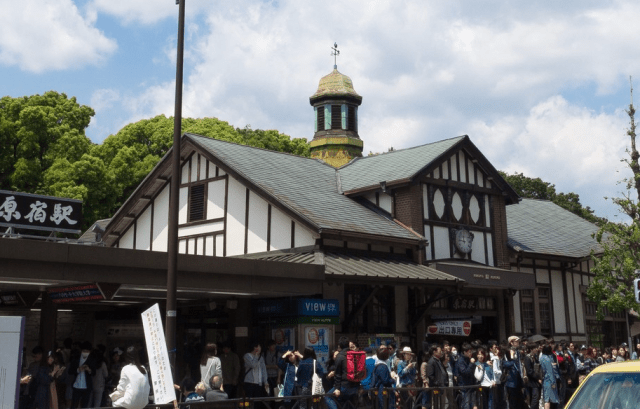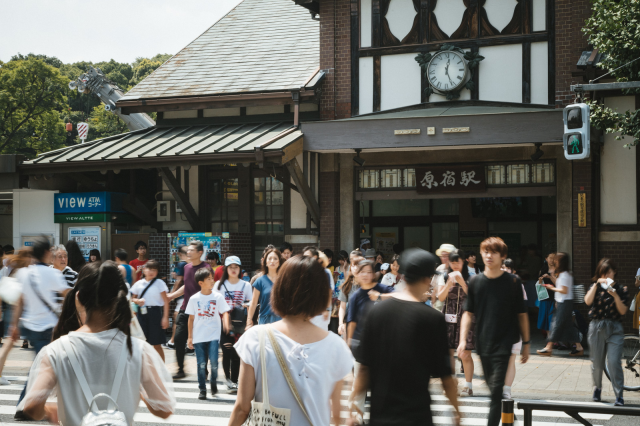
Farewell, Harajuku Station…and hello, Harajuku Station!
As a city that relies on rail to get around, there are a lot of train stations in downtown Tokyo. Harajuku Station, though, was one of the special ones.
After opening in 1924, Harajuku Station was able to survive both the firebombing of Tokyo during World War II and the relentless rebuilding that took place in the capital during the post-war period and boom years of the bubble economy. Despite the Harajuku neighborhood being the front line of new fashion developments in Japan, Harajuku Station eventually became the oldest wooden station in Tokyo.
However, that chapter in Harajuku history has come to a close. In the predawn hours of March 21, Harajuku Station, which lies along Japan Railways’ Yamanote Line, sent out its last trains before permanently closing, ending its 96 years of service to the community. A team of employees, in full dress uniform, lined up at the building’s entrance and called out “Thank you very much for these last 96 years” before bowing deeply and respectfully as the shutter came down for the last time.
原宿駅
— halspirits (mitame) (@mitame_language) March 20, 2020
さよなら木造校舎。
96年間おつかれさま! pic.twitter.com/0HkvhDTsYk
Many Tokyoites, as well as a large number of travelers with fond memories of their visits to Harajuku, were sad to say goodbye, but the parting was unavoidable. Japan Railways initially announced plans to rebuild the station all the way back in the summer of 2016, and though there were calls from some to save the building, the structure no longer complies with Tokyo’s fire safety codes. There’s also the fact that the Harajuku neighborhood has changed greatly since Harajuku Station was built, with the district’s world-class apparel retailers, restaurants, and other attractions turning it into one of the busiest rail hubs in the city despite the building’s compact dimensions and severely limited entrance/exit capacity.
Of course, Harajuku still needs a train station, and so roughly three hours after the station closed its replacement, also called Harajuku Station, opened.
▼ The new Harajuku Station
https://twitter.com/nhk_news/status/1241192546581217281The new station is located right next to its predecessor, and boats a number of improvements, starting with four times as much floor space. The new station has exits not only for the Omotesando and Takeshitadori shopping streets, but also a permanent exit to channel visitors towards Meiji Shrine (the former station’s Meiji Shrine exit was only open for a few days at the start of each new year), and the switch from a single-platform layout to a dual one should ease crowding as people wait for their trains. The new station also boasts a larger number of elevators and handicapped restroom stalls than the old building
▼ The pan-over from the old Harajuku Station to the new one can be seen at the eight-second mark in this video.
https://twitter.com/nhk_news/status/1241192546581217281This actually isn’t the first time for Harajuku Station to be replaced, as the recently decommissioned building wasn’t the original Harajuku Station either. That distinction actually goes to the Harajuku Station that was built in 1906, then replaced with the second-generation station a year after the Great Kanto Earthquake devastated Tokyo in 1923. For those wanting to snap one last commemorative photo of Harajuku Station II, though, the building isn’t scheduled to be demolished until after the end of the 2020 Tokyo Summer Olympics, and Japan Railways says it hopes to rebuild a replica of the wooden building on the same spot incorporating materials frm the structure that do meet safety codes.
Source: NHK News Web
Top image: Pakutaso
Insert images: Pakuaso
● Want to hear about SoraNews24’s latest articles as soon as they’re published? Follow us on Facebook and Twitter!


 Japan’s Harajuku Station to be rebuilt ahead of 2020 Tokyo Olympics
Japan’s Harajuku Station to be rebuilt ahead of 2020 Tokyo Olympics Harajuku Station will be demolished after the Tokyo Olympics and Paralympics
Harajuku Station will be demolished after the Tokyo Olympics and Paralympics Disney Store is all grown up with new branch designed for adult women opening in Tokyo
Disney Store is all grown up with new branch designed for adult women opening in Tokyo Tokyo’s newest mascot character is a rabbit who’s permanently sad【Photos】
Tokyo’s newest mascot character is a rabbit who’s permanently sad【Photos】 Moving to Tokyo? Here are the three best, most reasonable neighborhoods to live in
Moving to Tokyo? Here are the three best, most reasonable neighborhoods to live in McDonald’s new Happy Meals offer up cute and practical Sanrio lifestyle goods
McDonald’s new Happy Meals offer up cute and practical Sanrio lifestyle goods All-you-can-drink Starbucks and amazing views part of Tokyo’s new 170 meter-high sky lounge
All-you-can-drink Starbucks and amazing views part of Tokyo’s new 170 meter-high sky lounge Super Nintendo World expansion gets delayed for several months at Universal Studios Japan
Super Nintendo World expansion gets delayed for several months at Universal Studios Japan Studio Ghibli glasses cases let anime characters keep an eye on your spectacles
Studio Ghibli glasses cases let anime characters keep an eye on your spectacles We try out “Chan Ramen”, an underground type of ramen popular in the ramen community
We try out “Chan Ramen”, an underground type of ramen popular in the ramen community Kyoto’s 100 Demons yokai monster parade returns!
Kyoto’s 100 Demons yokai monster parade returns! More foreign tourists than ever before in history visited Japan last month
More foreign tourists than ever before in history visited Japan last month Starbucks reopens at Shibuya Scramble Crossing with new look and design concept
Starbucks reopens at Shibuya Scramble Crossing with new look and design concept Hungry and on the go? Top 10 ranking of ekiben at Tokyo’s Shinagawa Station
Hungry and on the go? Top 10 ranking of ekiben at Tokyo’s Shinagawa Station Mister Donut ready to make hojicha dreams come true in latest collab with Kyoto tea merchant
Mister Donut ready to make hojicha dreams come true in latest collab with Kyoto tea merchant Disney princesses get official manga makeovers for Manga Princess Cafe opening in Tokyo
Disney princesses get official manga makeovers for Manga Princess Cafe opening in Tokyo Beautiful new Final Fantasy T-shirt collection on the way from Uniqlo【Photos】
Beautiful new Final Fantasy T-shirt collection on the way from Uniqlo【Photos】 Is the new Shinkansen Train Desk ticket worth it?
Is the new Shinkansen Train Desk ticket worth it? Foreign English teachers in Japan pick their favorite Japanese-language phrases【Survey】
Foreign English teachers in Japan pick their favorite Japanese-language phrases【Survey】 Japanese convenience store packs a whole bento into an onigiri rice ball
Japanese convenience store packs a whole bento into an onigiri rice ball Studio Ghibli releases Kiki’s Delivery Service chocolate cake pouches in Japan
Studio Ghibli releases Kiki’s Delivery Service chocolate cake pouches in Japan Japan’s bone-breaking and record-breaking roller coaster is permanently shutting down
Japan’s bone-breaking and record-breaking roller coaster is permanently shutting down New definition of “Japanese whiskey” goes into effect to prevent fakes from fooling overseas buyers
New definition of “Japanese whiskey” goes into effect to prevent fakes from fooling overseas buyers Our Japanese reporter visits Costco in the U.S., finds super American and very Japanese things
Our Japanese reporter visits Costco in the U.S., finds super American and very Japanese things Studio Ghibli unveils Mother’s Day gift set that captures the love in My Neighbour Totoro
Studio Ghibli unveils Mother’s Day gift set that captures the love in My Neighbour Totoro Foreign passenger shoves conductor on one of the last full runs for Japan’s Thunderbird train
Foreign passenger shoves conductor on one of the last full runs for Japan’s Thunderbird train Domino’s Japan now sells…pizza ears?
Domino’s Japan now sells…pizza ears? New Japanese KitKat flavour stars Sanrio characters, including Hello Kitty
New Japanese KitKat flavour stars Sanrio characters, including Hello Kitty Kyoto creates new for-tourist buses to address overtourism with higher prices, faster rides
Kyoto creates new for-tourist buses to address overtourism with higher prices, faster rides Sales of Japan’s most convenient train ticket/shopping payment cards suspended indefinitely
Sales of Japan’s most convenient train ticket/shopping payment cards suspended indefinitely Sold-out Studio Ghibli desktop humidifiers are back so Totoro can help you through the dry season
Sold-out Studio Ghibli desktop humidifiers are back so Totoro can help you through the dry season Japanese government to make first change to romanization spelling rules since the 1950s
Japanese government to make first change to romanization spelling rules since the 1950s Ghibli founders Toshio Suzuki and Hayao Miyazaki contribute to Japanese whisky Totoro label design
Ghibli founders Toshio Suzuki and Hayao Miyazaki contribute to Japanese whisky Totoro label design Doraemon found buried at sea as scene from 1993 anime becomes real life【Photos】
Doraemon found buried at sea as scene from 1993 anime becomes real life【Photos】 Tokyo’s most famous Starbucks is closed
Tokyo’s most famous Starbucks is closed One Piece characters’ nationalities revealed, but fans have mixed opinions
One Piece characters’ nationalities revealed, but fans have mixed opinions We asked a Uniqlo employee what four things we should buy and their suggestions didn’t disappoint
We asked a Uniqlo employee what four things we should buy and their suggestions didn’t disappoint Princesses, fruits, and blacksmiths: Study reveals the 30 most unusual family names in Japan
Princesses, fruits, and blacksmiths: Study reveals the 30 most unusual family names in Japan Ultra-fashionable cat cafe set to open this month in Tokyo’s ultra-trendy Harajuku neighborhood
Ultra-fashionable cat cafe set to open this month in Tokyo’s ultra-trendy Harajuku neighborhood Tokyo subway ”phantom station” reveals itself to passengers for first time in nearly 90 years
Tokyo subway ”phantom station” reveals itself to passengers for first time in nearly 90 years Dramatic scenes at Harajuku Station as Typhoon Mindulle makes landfall in Japan
Dramatic scenes at Harajuku Station as Typhoon Mindulle makes landfall in Japan The top 20 places to visit in Tokyo, as chosen by travelers
The top 20 places to visit in Tokyo, as chosen by travelers New Harajuku-themed hotel room promises to surround you in pink and zany kawaii-ness
New Harajuku-themed hotel room promises to surround you in pink and zany kawaii-ness One of Tokyo’s low-key best rooftop views is about to disappear, so see it while you can【Photos】
One of Tokyo’s low-key best rooftop views is about to disappear, so see it while you can【Photos】 Want to choose the name of Tokyo’s most important new station? Here’s your chance!
Want to choose the name of Tokyo’s most important new station? Here’s your chance! Cold Stone Creamery Japan’s special year-end takeout box is perfect if you have a sweet tooth
Cold Stone Creamery Japan’s special year-end takeout box is perfect if you have a sweet tooth Typhoon Hagibis turns Tokyo into an eerie ghost town【Pics, Video】
Typhoon Hagibis turns Tokyo into an eerie ghost town【Pics, Video】 Series of steamy shojo manga illustrations takes on the sizzling topic of IT security
Series of steamy shojo manga illustrations takes on the sizzling topic of IT security Two Tokyo train stations getting Harry Potter-style makeovers
Two Tokyo train stations getting Harry Potter-style makeovers We visit Tokyo Tapioca Land in Harajuku
We visit Tokyo Tapioca Land in Harajuku The train station that stayed open for a single school girl finally closes down
The train station that stayed open for a single school girl finally closes down Tokyo’s busiest train stations have a new, free, English-compatible navigation app
Tokyo’s busiest train stations have a new, free, English-compatible navigation app Nine injured in Tokyo after man drives car into pedestrians on Takeshita Street in Harajuku
Nine injured in Tokyo after man drives car into pedestrians on Takeshita Street in Harajuku
Leave a Reply